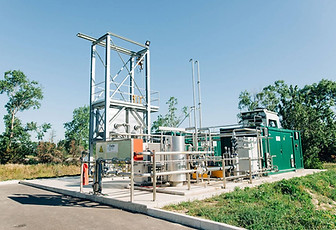
Anaerobic Digesting
Repurposing agricultural waste, manures, municipal waste, food and processing waste materials from manufacturers, industrial byproducts and more.

Biogas from Waste Disposal
Biogas from Waste Disposal and treatment of biological waste represent a major challenge for the waste industry. For a wide range of organic substances from agriculture, foodstuff of feed industries, anaerobic digestion is a superior alternative to composting. Biogas – a mixture of both methane and carbon dioxide – is created during anaerobic digestion and serves as a high-energy renewable fuel that can be used as a substitute for fossil fuels. Biogas-fueled gas engines improve waste management while maximizing the use of an economical energy supply.

Biogas Creation
Biogas results from anaerobic fermentation of organic materials. As a metabolic product of the participating methanogens and acidogenic bacteria, the prerequisites for its production are a lack of oxygen, a pH value from 6.5 to 7.5 and a constant temperature of 35-45°C (mesophilic) or 45-55°C (thermophilic). The digestion period or retention period is typically between 10 and 30 days depending upon the type of digestion employed. The anaerobic digestion systems of today operate largely within the mesophilic temperature range.

Conversion Steps from Waste to Power
The process of biogas generation is divided into four steps:
-
Preparation of the input waste material – including removal of physical contaminants, particle size reduction & pasteurization
-
Digestion (fermentation), consisting of hydrolysis, acetogenesis, acidogenesis and methanogenesis
-
Conversion of the biogas to renewable electricity and useful heat
-
Post-treatment of the digestate Initially the feedstock to the digesters is received in a primary pit or liquid storage tank.
From here it is loaded into the digester by various means depending upon the constitution of waste materials. In the digestion tanks a series of biological processes are harnessed in order to produce biogas. Hydrolysis is the process where the organic material is solubilized into the digestion liquid. It then undergoes the intermediate steps of acidogenesis and acetogenesis which create the precursor molecules for methanogenesis. Methanogens feed off these precursors and produce methane as a cellular waste product. The biogas containing this biologically-derived methane is contained and captured in a gas storage tank which is located separately to the main digester, or alternatively can form its roof. The gas storage tank acts as a buffer in order to balance fluctuations in the production of gas in the digester.


Anaerobic Digester Outputs
Anaerobic digestion produces two valuable outputs: biogas and digestate.
Biogas
Biogas is composed of methane (CH4), which is the primary component of natural gas, at a relatively high percentage (50 to 75 percent), carbon dioxide (CO2), hydrogen sulfide (H2S), water vapor, and trace amounts of other gases. The energy in biogas can be used like natural gas to provide heat, generate electricity, and power cooling systems, among other uses. Biogas can also be purified by removing the inert or low-value constituents (CO2, water, H2S, etc.) to generate renewable natural gas (RNG). This can be sold and injected into the natural gas distribution system, compressed and used as vehicle fuel, or processed further to generate alternative transportation fuel, energy products, or other advanced biochemicals and bioproducts.

Biogas Recovery in Agriculture
Biogas is created when animal waste, or manure, decomposes. Capturing biogas from cattle, hog and poultry farms can reduce greenhouse gas emissions and recovering the methane from the biogas can provide a cost-effective source of renewable energy. Recovered biogas can be an energy source for electricity, heating or transportation.

Digestate
Digestate is the residual material left after the digestion process. It is composed of liquid and solid portions. These are often separated and handled independently, as each have value that can be realized with varying degrees of post processing.
With appropriate treatment, both the solid and liquid portions of digestate can be used in many beneficial applications, such as animal bedding (solids), nutrient-rich fertilizer (liquids and solids), a foundation material for bio-based products (e.g., bioplastics), organic-rich compost (solids), and/or simply as soil amendment (solids), the latter of which may include the farm spreading the digestate on the field as fertilizer. Digestate products can be a source of revenue or cost savings,and are often pursued to increase the financial and net-environmental benefit of an AD/biogas project.

Waste to Energy & Biodigester Capabilities
TEXZON UTILITIES provides the following services to support Biodigester implementation:
-
Study of current waste biproducts and expenditures
-
Study of methane and CO2 emissions
-
Conceptual design, viability, and feasibility studies
-
RNG, biofuel and energy production
-
Total installed (turnkey) cost estimate
-
ROI, IRR and cashflow – payback schedule for system and biogas credits
-
Combined Heat and Power applications
-
Electrical and mechanical engineering
-
Construction & project management
-
Load and volume analysis
-
Biogas buyers, brokerage, and credits
-
Utility interface and interconnection
-
Structural engineering
-
Environmental and regulatory permitting and applications support
-
Software: Helioscope, Energy Toolbase, CAD, CATIA, delos, etc.
-
Technical field services and project management
-
Independent engineering reviews & inspections
-
Civil engineering and environmental impact analysis / design criteria
-
In-House grant writing, defining federal and state incentives, etc.
-
Financial products, project capital, municipal bonds, and funding incentives
* Photos courtesy of Clarke Energy


